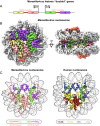Viral histones: pickpocket's prize or primordial progenitor?
- PMID: 35624484
- PMCID: PMC9145170
- DOI: 10.1186/s13072-022-00454-7
Viral histones: pickpocket's prize or primordial progenitor?
Abstract
The common histones H2A, H2B, H3, and H4 are the characteristic components of eukaryotic nucleosomes, which function to wrap DNA and compact the genome as well as to regulate access to DNA for transcription and replication in all eukaryotes. In the past two decades, histones have also been found to be encoded in some DNA viruses, where their functions and properties are largely unknown, though recently histones from two related viruses have been shown to form nucleosome-like structures in vitro. Viral histones can be highly similar to eukaryotic histones in primary sequence, suggesting they have been recently picked up from eukaryotic hosts, or they can be radically divergent in primary sequence and may occur as conjoined histone doublets, triplets, or quadruplets, suggesting ancient origins prior to the divergence of modern eukaryotes. Here, we review what is known of viral histones and discuss their possible origins and functions. We consider how the viral life cycle may affect their properties and histories, and reflect on the possible roles of viruses in the origin of the nucleus of modern eukaryotic cells.
© 2022. The Author(s).
Conflict of interest statement
The authors declare that they have no competing interests.
Figures




Similar articles
-
Nucleosomes at the Dawn of Eukaryotes.Genome Biol Evol. 2024 Mar 2;16(3):evae029. doi: 10.1093/gbe/evae029. Genome Biol Evol. 2024. PMID: 38366053 Free PMC article. Review.
-
Self-assembling viral histones are evolutionary intermediates between archaeal and eukaryotic nucleosomes.Nat Microbiol. 2024 Jul;9(7):1713-1724. doi: 10.1038/s41564-024-01707-9. Epub 2024 May 28. Nat Microbiol. 2024. PMID: 38806669 Free PMC article.
-
Phylogenetic analysis of the core histone doublet and DNA topo II genes of Marseilleviridae: evidence of proto-eukaryotic provenance.Epigenetics Chromatin. 2017 Nov 28;10(1):55. doi: 10.1186/s13072-017-0162-0. Epigenetics Chromatin. 2017. PMID: 29179736 Free PMC article.
-
Histone release during transcription: NAP1 forms a complex with H2A and H2B and facilitates a topologically dependent release of H3 and H4 from the nucleosome.Biochemistry. 2004 Mar 9;43(9):2359-72. doi: 10.1021/bi035737q. Biochemistry. 2004. PMID: 14992573
-
Nucleosome unwrapping and unstacking.Curr Opin Struct Biol. 2020 Oct;64:119-125. doi: 10.1016/j.sbi.2020.06.020. Epub 2020 Jul 29. Curr Opin Struct Biol. 2020. PMID: 32738677 Review.
Cited by
-
The interplay between viral molecular mimicry and host chromatin dynamics.Nucleus. 2023 Dec;14(1):2216560. doi: 10.1080/19491034.2023.2216560. Nucleus. 2023. PMID: 37218181 Free PMC article. Review.
-
Virologs, viral mimicry, and virocell metabolism: the expanding scale of cellular functions encoded in the complex genomes of giant viruses.FEMS Microbiol Rev. 2023 Sep 5;47(5):fuad053. doi: 10.1093/femsre/fuad053. FEMS Microbiol Rev. 2023. PMID: 37740576 Free PMC article.
-
Mirusviruses link herpesviruses to giant viruses.Nature. 2023 Apr;616(7958):783-789. doi: 10.1038/s41586-023-05962-4. Epub 2023 Apr 19. Nature. 2023. PMID: 37076623 Free PMC article.
-
Characterization of Medusavirus encoded histones reveals nucleosome-like structures and a unique linker histone.Nat Commun. 2024 Oct 23;15(1):9138. doi: 10.1038/s41467-024-53364-5. Nat Commun. 2024. PMID: 39443461 Free PMC article.
-
Nucleosomes at the Dawn of Eukaryotes.Genome Biol Evol. 2024 Mar 2;16(3):evae029. doi: 10.1093/gbe/evae029. Genome Biol Evol. 2024. PMID: 38366053 Free PMC article. Review.
References
Publication types
MeSH terms
Substances
Grants and funding
LinkOut - more resources
Full Text Sources
Miscellaneous

